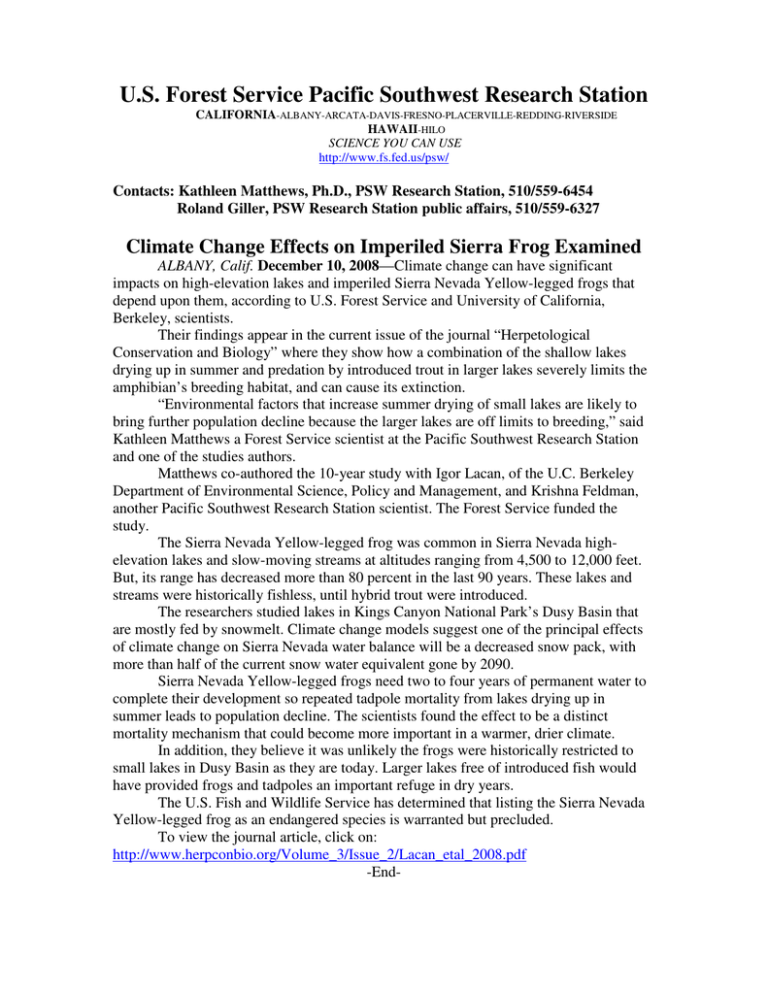U.S. Forest Service Pacific Southwest Research Station
advertisement

U.S. Forest Service Pacific Southwest Research Station CALIFORNIA-ALBANY-ARCATA-DAVIS-FRESNO-PLACERVILLE-REDDING-RIVERSIDE HAWAII-HILO SCIENCE YOU CAN USE http://www.fs.fed.us/psw/ Contacts: Kathleen Matthews, Ph.D., PSW Research Station, 510/559-6454 Roland Giller, PSW Research Station public affairs, 510/559-6327 Climate Change Effects on Imperiled Sierra Frog Examined ALBANY, Calif. December 10, 2008—Climate change can have significant impacts on high-elevation lakes and imperiled Sierra Nevada Yellow-legged frogs that depend upon them, according to U.S. Forest Service and University of California, Berkeley, scientists. Their findings appear in the current issue of the journal “Herpetological Conservation and Biology” where they show how a combination of the shallow lakes drying up in summer and predation by introduced trout in larger lakes severely limits the amphibian’s breeding habitat, and can cause its extinction. “Environmental factors that increase summer drying of small lakes are likely to bring further population decline because the larger lakes are off limits to breeding,” said Kathleen Matthews a Forest Service scientist at the Pacific Southwest Research Station and one of the studies authors. Matthews co-authored the 10-year study with Igor Lacan, of the U.C. Berkeley Department of Environmental Science, Policy and Management, and Krishna Feldman, another Pacific Southwest Research Station scientist. The Forest Service funded the study. The Sierra Nevada Yellow-legged frog was common in Sierra Nevada highelevation lakes and slow-moving streams at altitudes ranging from 4,500 to 12,000 feet. But, its range has decreased more than 80 percent in the last 90 years. These lakes and streams were historically fishless, until hybrid trout were introduced. The researchers studied lakes in Kings Canyon National Park’s Dusy Basin that are mostly fed by snowmelt. Climate change models suggest one of the principal effects of climate change on Sierra Nevada water balance will be a decreased snow pack, with more than half of the current snow water equivalent gone by 2090. Sierra Nevada Yellow-legged frogs need two to four years of permanent water to complete their development so repeated tadpole mortality from lakes drying up in summer leads to population decline. The scientists found the effect to be a distinct mortality mechanism that could become more important in a warmer, drier climate. In addition, they believe it was unlikely the frogs were historically restricted to small lakes in Dusy Basin as they are today. Larger lakes free of introduced fish would have provided frogs and tadpoles an important refuge in dry years. The U.S. Fish and Wildlife Service has determined that listing the Sierra Nevada Yellow-legged frog as an endangered species is warranted but precluded. To view the journal article, click on: http://www.herpconbio.org/Volume_3/Issue_2/Lacan_etal_2008.pdf -End-











